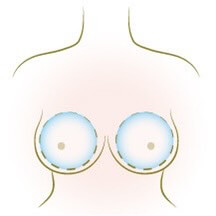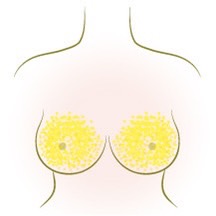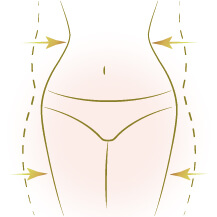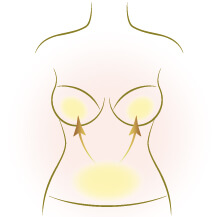Breast cosmetic surgery
Autologous Fat Breast Augmentation Surgery
BREAST PLASTIC SURGERY
BREAST PLASTIC SURGERY
Autologous Fat Breast Augmentation Surgery
- Principle
- Before and After
- Case Study
Many women aspire to have full breasts and a beautiful career line.
Before having breast augmentation surgery, have a breast screening!
Every woman who wants to get breast augmentation must first get screened for breast cancer. Before surgery, Dr. Chen advises having a breast ultrasound performed. No reservations regarding the lesions can be raised prior to discussion because there are no aberrant nodules, abnormal breast look, nipple bleeding, depression, etc. Breast enlargement surgery.
Unlike breast augmentation surgery, breast augmentation with autologous fat cannot be completed in one step!
Autologous fat breast augmentation can only increase half a cup to one cup at a time, and if you want to accomplish a greater cup upgrade, you may need numerous operations for breast augmentation or direct breast augmentation. Fat grafting can only utilize your own fat, not that of other people. Decide on breast implants.
How is autologous fat breast augmentation surgery performed?
After several small wounds of 0.5-1 cm that are easy to hide scars, the fat is extracted from the places where body fat is easy to accumulate (such as the abdomen and thighs), and then processed to remove blood and fibrous tissue, and then inject an even amount into the breast Subcutaneous fat and muscle layer to increase breast volume cup. Depending on the amount of liposuction and the size of the breasts, each breast transplant is about 250-350cc, which can be increased by half to one cup. Autologous fat transplantation has the problem of fat survival rate. In the past, it was reported in the literature that the fat survival rate was about half, which greatly affects the individual’s constitution. It may not be absolutely related to the way of liposuction and preservation. The fat that does not survive will be absorbed by the body. There is no exclusion issue. The most feared thing about fat transplantation is that too much transplantation at one time can easily cause lumps, calcifications, necrosis, and even cysts, and infection. Not enough can be replenished, but too much can be troublesome to deal with.
Comparison of Autologous Fat Breast Augmentation and Prosthetic Breast augmentation
| Autologous Fat Breast Augmentation | Prosthetic Breast Augmentation | |
|---|---|---|
| Principle Features | The breast is fully scar-free once the fat is transplanted there from other regions of the body. Can simultaneously shape other bodily parts (abdomen and thighs) | Breast implants at a single location. |
| Cons | It cannot be done all at once; you may need to replenish fat numerous times. If you transplant too much fat, you run the danger of developing calcifications, necrosis, cysts, and clumps. After liposuction, compression garments are essential. | Scars on your underarms or breasts Risks associated with the prosthesis include capsular contracture, infection, displacement, rupture, and more. |
| Recovery Period | Have had breast augmentation and want to modify the wrong scale, partial plumpness or obvious edge area. Want to increase the cup size in moderation, but I am afraid of breast implant complications. | Customers who wish to instantly update their cups. Not enough body fat to pump |
| Principle features | 5-7 days | 5-7 days |
Anesthesia and Preoperative Planning
1.It is recommended to wear a pressure garment for three months after liposuction,
and it is recommended to make a pressure garment before surgery
2. If you have any drug allergies, you need to inform your doctor before surgery
3.It is necessary to stop anticoagulant drugs for a week before surgery to avoid intraoperative and postoperative bleeding
4.It is also recommended to avoid smoking for at least two weeks before and after surgery
5.If you have systemic diseases such as high blood pressure, heart disease, diabetes, abnormal thyroid function, etc., it is recommended that specialists control and stabilize before undergoing surgery
6.If you or your family have swollen feet or hypertrophic scars, please inform your doctor before surgery
7.Breast augmentation surgery is recommended to be performed under general anesthesia, with basic blood draw, chest X-ray and electrocardiogram before surgery
2. If you have any drug allergies, you need to inform your doctor before surgery
3.It is necessary to stop anticoagulant drugs for a week before surgery to avoid intraoperative and postoperative bleeding
4.It is also recommended to avoid smoking for at least two weeks before and after surgery
5.If you have systemic diseases such as high blood pressure, heart disease, diabetes, abnormal thyroid function, etc., it is recommended that specialists control and stabilize before undergoing surgery
6.If you or your family have swollen feet or hypertrophic scars, please inform your doctor before surgery
7.Breast augmentation surgery is recommended to be performed under general anesthesia, with basic blood draw, chest X-ray and electrocardiogram before surgery
Recovery Process and Post-operative Care:
1. You can choose to stay in the hospital for one day or go home on the same day after the operation
2. Prophylactic antibiotics, anti-inflammatory, analgesic, detumescence, hemostasis, and other oral medicines will be given for three days after surgery;
3. Wound care: ointment will be prescribed after surgery, and the dressing will be changed twice a day: in the morning and after bathing in the evening
4. The degree of postoperative bruising and swelling varies from person to person. Generally, it is most obvious 3 or 4 days after the operation, and most patients can be relieved about two weeks after the operation.
5. You can wash your face and take a bath normally after the operation. But avoid swimming, splashing in the water by the seaside stream and soaking in hot springs
6. Avoid strenuous activities after surgery, such as heavy training, running, mountaineering, rock climbing…etc. It can increase blood pressure and cause bleeding, or open wounds.
7. The diet is generally normal, but avoid tobacco, alcohol and spicy food (too spicy and salty)
8. After liposuction, it is advised to wear a compression garment for three months.
2. Prophylactic antibiotics, anti-inflammatory, analgesic, detumescence, hemostasis, and other oral medicines will be given for three days after surgery;
3. Wound care: ointment will be prescribed after surgery, and the dressing will be changed twice a day: in the morning and after bathing in the evening
4. The degree of postoperative bruising and swelling varies from person to person. Generally, it is most obvious 3 or 4 days after the operation, and most patients can be relieved about two weeks after the operation.
5. You can wash your face and take a bath normally after the operation. But avoid swimming, splashing in the water by the seaside stream and soaking in hot springs
6. Avoid strenuous activities after surgery, such as heavy training, running, mountaineering, rock climbing…etc. It can increase blood pressure and cause bleeding, or open wounds.
7. The diet is generally normal, but avoid tobacco, alcohol and spicy food (too spicy and salty)
8. After liposuction, it is advised to wear a compression garment for three months.
Follow-ups and Complications:
1. Risks of infection, hemorrhage, inadequate wound healing, etc. exist with every procedure.
2. Potential side effects of breast augmentation include scarring, breast implant rupture, displacement, capsular contracture, incorrect positioning of the areola and nipple, and worsening nipple sensation.
3. Although all surgeries leave scars, the plastic surgeon will meticulously stitch and use extremely thin sutures to tuck the scars into the creases of the skin and the borders of the hair, making them less noticeable and more difficult to locate. Even so, the scar may still be momentarily red and elevated (1-2 months after the operation) until it stabilizes, but after two to six months the scar will often gradually fade and become less noticeable. climbed up.
2. Potential side effects of breast augmentation include scarring, breast implant rupture, displacement, capsular contracture, incorrect positioning of the areola and nipple, and worsening nipple sensation.
3. Although all surgeries leave scars, the plastic surgeon will meticulously stitch and use extremely thin sutures to tuck the scars into the creases of the skin and the borders of the hair, making them less noticeable and more difficult to locate. Even so, the scar may still be momentarily red and elevated (1-2 months after the operation) until it stabilizes, but after two to six months the scar will often gradually fade and become less noticeable. climbed up.
















